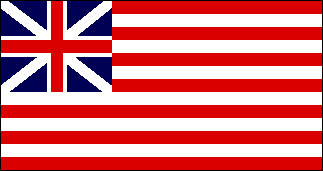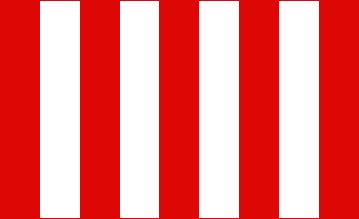The Continental Colors

Continental Colors, 1775-1777

Beginning in 1765, protests of the duties and taxes and stamps required by Parliment began in the colonies. James Otis, in a famous speech characterized by John Adams as being "then and there was the child Independence born," before a court in Massachusetts proclaimed that it was a violation of God's law to impose "Taxation without Representation." Benjamin Franklin's embelem of a Rattlesnake cut into pieces with the motto "Unite or Die" was resurrected to remind the colonists of the effects of disunion.
Liberty trees and liberty poles were erected or dedicated and Liberty flags were flown. It was subsequent to a protest of the Stamp Act held under a particular Elm tree in Boston, known thereafter as "the Liberty Tree," that the Sons of Liberty were formed and they met under this tree. Later, the British cut the tree down but the Sons replaced it with a Liberty pole. Their flag of nine alternating red and white vertical stripes was flown from this pole.

In 1775, following a long history of local flags, the New England forces who were surrounding Boston remembered their New England Flag, a red flag with a white canton bearing a Pine Tree. Other versions of this flag were used, particularly on ships who wore a white flag bearing the Pine Tree, sometimes with the motto "An Appeal to Heaven."
The earliest reference to this flag is apparently the raising of it on board the Continental ship "Alfred" on December 3, 1775 at Philadelphia supposedly by John Paul Jones. The flag was made by Margaret Manny of Philadelphia; she was paid one pound, two shillings and eight pence for her work on December 2, 1775.
On January 1st, 1776, General George Washington, who had been appointed to command the American Army by the Continental Congress, ordered the hoisting of the "Union Flag in compliment to the United Colonies" on a 76 foot tall pole on a hill in Somerville, just outside of Boston. The flag he was talking about is known to us today as "the Continental Colors," and was a British red ensign defaced by some white stripes, totalling 13 red and white stripes. There is some conjecture that the stripes of the Sons of Liberty flag may have inspired the stripes on the Continental Colors but there is no documentary evidence of this.
Copies of a speech recently made by King George III, in which he called on Americans to lay down their arms, had just been sent to Washington's camp. The raising of this flag was noted by Washington thusly: "behold! it was received in Boston as a token of the deep Impression the Speech had made upon us, and as a signal of Submission ... by this time I presume they begin to think it strange that we have not made a formal surrender of our Lines ..." This flag, of course, was used as a sign of loyalty by Americans to traditional English values and laws, which the Americans were intent upon preserving.
Other references to this flag exist:
It should be noted that the Continental Colors officially passed from existence on June 14, 1777 when the Stars and Stripes were born, however there are a few documented uses of it after that date, as noted.
Return to the US Flag History Index Page
To the Vexillology Page
To the Maine Flags Pages
To the New England Vexillological Assn. Page
To the New England Journal of Vexillology Page
To the New England Flag Page